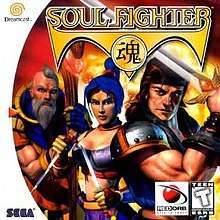Soul Fighter
Soul Fighter is a 3D beat 'em up video game developed by Toka and published by TLC Multimedia for the Sega Dreamcast in 1999.
| Soul Fighter | |
|---|---|
 North American Dreamcast cover art | |
| Developer(s) | Toka |
| Publisher(s) | TLC Multimedia[lower-alpha 1] |
| Platform(s) | Dreamcast |
| Release | |
| Genre(s) | Beat 'em up |
| Mode(s) | Single-player |
Gameplay
Plot
An evil spell of Queen Antea has fallen on the Kingdom of Gomar. As a mysterious mist envelopes the kingdom, the inhabitants turn into vicious creatures. A fearless warrior (Atlus), a female spy (Sayomi), and a powerful wizard (Orion) have escaped the fate of their fellow villagers. They must now search for and capture souls in order to reverse the curse.
Development
Soul Fighter was developed by the French company Toka with help from upstart company Piggyback Interactive.[2] The 15-person team at Toka created the game using the 3dfx Interactive Glide API for PC hardware in the same fashion as Midway Games' San Francisco Rush, NFL Blitz, and NBA Showtime. Although Soul Fighter cannot be run with Glide on the Dreamcast, the software allowed Toka to port the game from the PC to console in less than three weeks.[3]
Production on Soul Fighter was originally set to be finished in July 1999 with the game slated for release at the North American launch of the Dreamcast.[3] A delay set its release back to an October ship date.[2] After settling on a publisher in Mindscape, Soul Fighter was delayed again from an October 1999 release to the following month.[4] Piggyback consulted with a Japanese publisher at one point to transform Soul Fighter into an arcade game; the company had also considered a version for the PlayStation 2.[3] A planned port of the game for the GameCube was announced but eventually cancelled.[5]
Reception
Blake Fischer reviewed the Dreamcast version of the game for Next Generation, rating it one star out of five, and stated that "This is perhaps the first spinning-world simulator to run at a dizzying 60fps. Now, excuse us, we have to find the toilet and vomit."[6]
Soul Fighter received mostly unfavorable reviews, such as IGN's (2.5 "Painful"),[7] GameSpot's (4.8 "a chore, thanks to the tedious gameplay and even worse control"),[8] and Game Revolution's ("simplistic gameplay and lack of a multiplayer mode") reviews.[9]
References
- White, Matt (November 22, 1999). "Soul Fighter in Stores Now". IGN. Retrieved January 5, 2014.
- Justice, Brandon (August 12, 1999). "Soul Fighter Slips". IGN. Retrieved January 5, 2014.
- Kennedy, Sam (June 16, 1999). "Hands-on: Soul Fighter". GameSpot. CBS Interactive. Retrieved January 5, 2014.
- Gantayat, Anoop (October 14, 1999). "Soul Fighter Bitten by the Delay Bug". IGN. Retrieved January 5, 2014.
- IGN staff (February 6, 2002). "Soul Fighter, Hidden Invasion Announced". IGN. Retrieved April 5, 2012.
- Fischer, Blake (March 2000). "Finals". Next Generation. Vol. 3 no. 3. Imagine Media. p. 87.
- Justice, Brandon (November 23, 1999). "Review: Soul Fighter". IGN. Retrieved January 5, 2014.
- Bartholow, Peter (1999). "Soul Fighter Review". GameSpot. CBS Interactive. Retrieved January 5, 2014.
- Colin (January 1, 2000). "Soul Fighter Review". Game Revolution. Net Revolution Inc. Retrieved January 5, 2014.
- Released under the Red Orb Entertainment label in North America, and Mindscape in PAL regions.